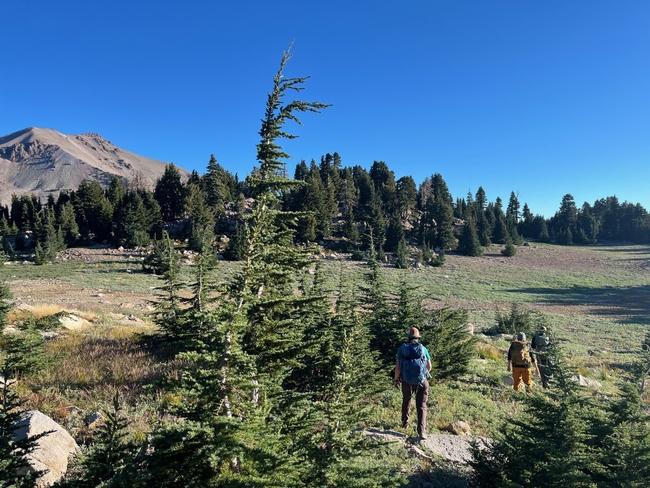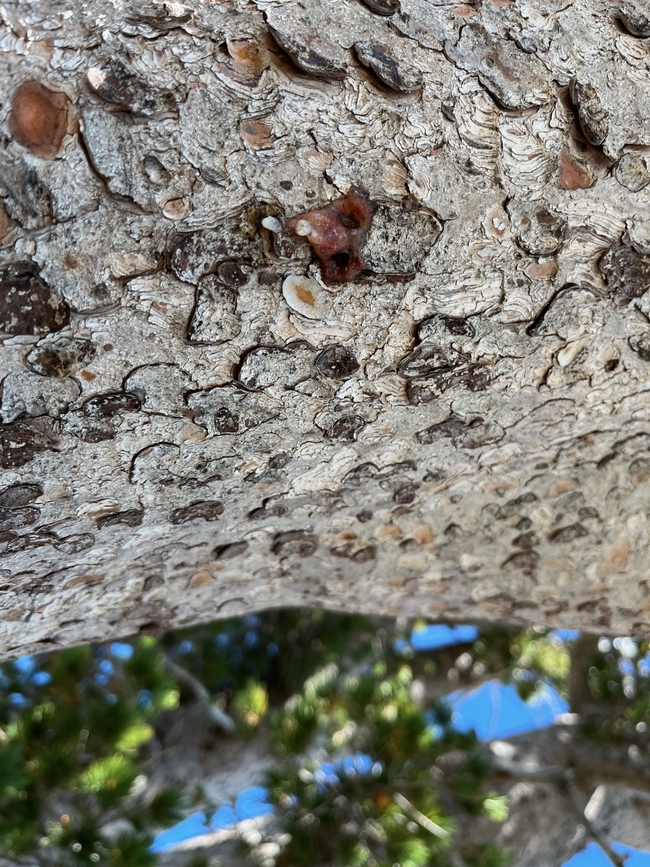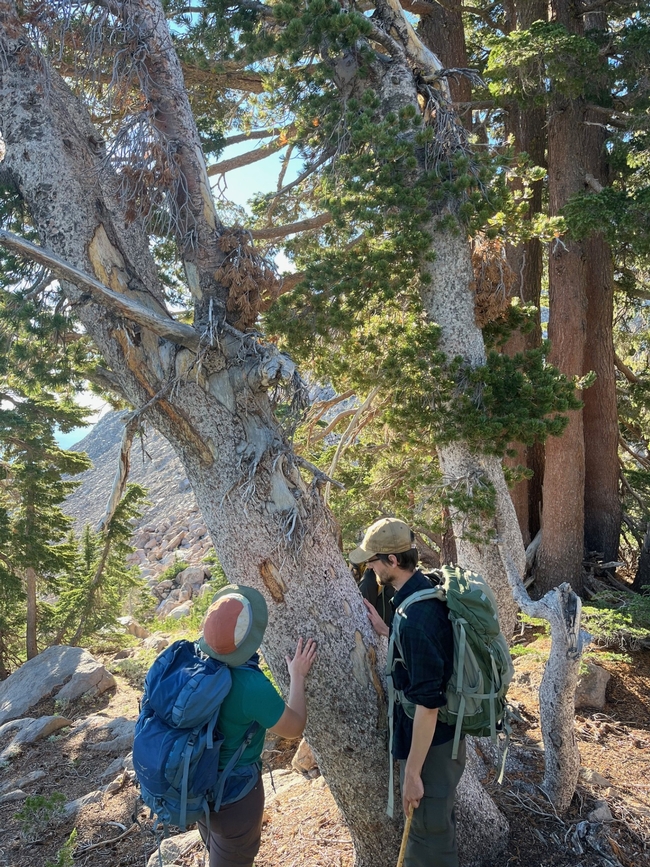Early one morning this fall, three National Park Service researchers from the Klamath Inventory and Monitoring Network (KLMN) scrambled over minivan-sized boulders on a remote butte in Lassen Volcanic National Park. Their goal -- to reach plot three, the most difficult to access site in the National Park Service's Whitebark Pine Monitoring Network at Lassen.
Since 2012, the KLMN has studied whitebark pine populations at Crater Lake and Lassen Volcanic National Parks to assess species health and long-term trends, specifically threats from blister rust and mountain pine beetle. At Lassen Volcanic, the Network has thirty 50m2 plots, with ten plots sampled each year. Dr. Lauren Youngblood, an Ecologist with the KLMN, is the lead scientist for the whitebark pine monitoring program at Crater Lake and Lassen Volcanic National Parks. When assessing whitebarks within each plot, Youngblood and her crew measure tree size (diameter at breast height), tree height, and percent of live canopy while also assessing for encroachment from other conifers and signs of white pine blister rust infection or mountain pine beetle attack.
Youngblood and her team did reach plot three that day, where signs of blister rust infection, mountain pine beetle attack, and associated mortality were detected on several whitebarks. Read on to learn more about whitebark pines, their uncertain future, and a conversation with Youngblood.
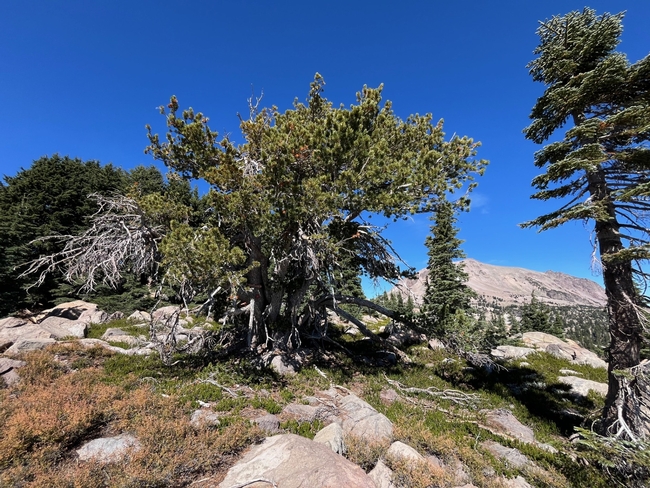
An Iconic Species
Whitebark pine is a long-lived, high elevation conifer found in the mountains of Western North America. In the Cascades, including at Lassen Volcanic National Park, the species is mostly found above 7000 feet. Despite the harsh summer and winter environments of their range, whitebarks can survive for hundreds of years, often living between 500 and 1000 years. The oldest known whitebark is over 1200 years old (National Park Service 2014).
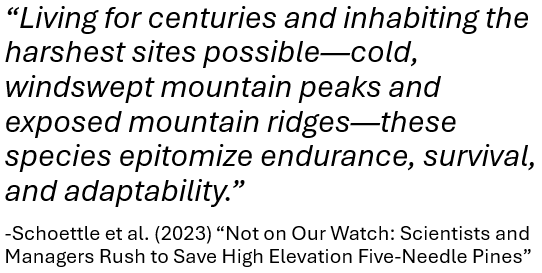
Whitebark pine are recognized as both a foundation and keystone species, serving many critical roles in their ecosystems including increasing biodiversity, providing food and shelter for other species, capturing and retaining snowpack, reducing erosion, and improving water quality (National Park Service 2014; Schoettle et al. 2023; Ellison et al. 2005).
However, despite their longevity and capacity to endure harsh environmental conditions, whitebark pine are under threat. In recent years, white pine blister rust (a non-native and invasive fungus) and mountain pine beetle have led to a significant decline of whitebark pine across much its range. According to one study, approximately 54% of standing whitebark trees were dead as of 2019 (Goeking and Windmuller-Campione 2021). This high level of mortality represents a significant increase from 2009, when about 43% of standing whitebarks were dead, and 1999, when the figure was just 12% (Goeking and Windmuller-Campione 2021; Oswalt et al. 2019). The outlook for whitebark pine is bleak enough that it was listed as threatened with potential extinction under the Endangered Species Act in 2022 (whitebark pine is listed as an endangered species in Canada).
Despite these statistics, there is some reason for optimism. Recent research found high levels of resistance to white pine blister rust in certain whitebark pine populations (Sniezko et al. 2024). At Crater Lake, whitebarks have already been planted as part of a restoration planting and genetic trial. While young now, these trees may live hundreds of years.
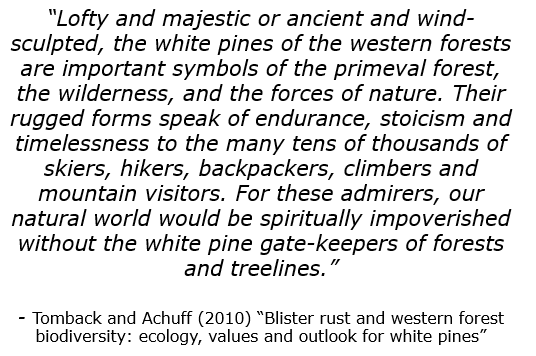
A Conversation with Dr. Lauren Youngblood, Ecologist leading the Klamath Network's Whitebark Pine monitoring program
What are the objectives of the Klamath Inventory & Monitoring Network's Whitebark Pine Monitoring Network?
The objectives of our whitebark pine monitoring protocol are to quantify: 1) infection and death rates of whitebark pine from blister rust disease, mountain pine beetle, and other agents (e.g., fire, native diseases, etc.) over time, and 2) associated plant species composition. To meet our objectives, we monitor evidence of infection from blister rust and mountain pine beetles, as well as tree and seedling growth, at our 60 established plots in Crater Lake and Lassen Volcanic National Park.
What trends in whitebark pine health have been observed since the program began in 2012?
A recent report found that Whitebark pine in Crater Lake and Lassen Volcanic National Parks had higher rates of blister rust infestation and higher associated crown kill compared to other white pines in nearby western national parks (Reilly et al., 2022). Overall, we see lower incidence of blister rust at Lassen Volcanic as opposed to Crater Lake National Park -- and this is likely the result of environmental interactions, like elevation, temperature, and humidity shaping blister rust transmission. Analyses are currently underway to quantify how blister rust, mountain pine beetles, and abiotic factors – including novel thermal and hydric regimes due to climate change-- interact to shape whitebark pine populations in Crater Lake and Lassen Volcanic National Parks. As of today, we've completed four rounds of repeat sampling in our 2023 season, and we completed our 5th visit to panel 1 plots in the 2024 season. We're just now getting to the point where we have enough repeat sampling to facilitate exciting trend analyses, so stay tuned for future reports!
Any optimistic statements about the future of whitebark pines?
While some of what I've said above may sound pessimistic, I do feel hopeful about the future of whitebark pine populations in our Klamath Network parks. Through our analyses, we've been able to identify a handful of whitebark pine trees that are potentially resistant to blister rust. Crater Lake has a strong conservation program that works with the Dorena Genetic Resource Center to study the genetic underpinning of blister rust resistance and has been replanting rust resistant seedlings in the park with great success. This work was largely led by Jen Hooke, who was a vegetation Ecologist at CRLA for many years before moving to a position with the USFS last year. You can read more about that program here. In addition to long-term monitoring, conservation programs like these will be key to preserving whitebark pine populations in our parks in the future.
RESOURCES AND FURTHER READING:
Ellison A. M., Bank, M., Clinton B., Colburn E., Elliott K., Ford, C., Foster D., Kloeppel B., Knoepp J., Lovett G., Mohan J., Orwig D., Rodenhouse N.; Sobczak W, Stinson K., Stone J., Swan C., Thompson V., Von Holle B., and Webster J. 2005. Loss of foundation species: Consequences for the structure and dynamics of forested ecosystems. Frontiersin Ecology and the Environment 3, 479–486. Doi: 10.1890/1540-9295(2005)003[0479:LO-FSCF]2.0.CO;2.
Goeking S.A. and Windmuller-Campione M.A. 2021. Comparative species assessments of five-needle pines throughout the western United States. Forest Ecology and Management. 496(2021)119438. https://doi.org/10.1016/j.foreco.2021.119438.
National Park Service, U.S. Department of the Interior. 2014. “Resource Brief: Whitebark Pine (Pinus abicaulis).” Crown of the Continent Research Learning Center. April 2014. Whitebark Pine Resource Brief.
National Park Service, U.S. Department of the Interior. 2022. “Status of White Pines Across Five Western National Park Units – Initial Assessment of Stand Structure and Condition, Revised October 2021.” National Resource Stewardship and Science Natural Resource Report NPS/KLMN/NRR—2022/2342.
Oswalt S.N., Smith W.B., Miles P.D., and Pugh S.A., 2019. Forest Resources of the United States, 2017: A Technical Document Supporting the Forest Service 2020 RPA Assessment. Gen Tech Rep WO-97 Wash. DC US Dep. Agric. For. Serv. Wash. Off., pp. 97. https://doi.org/10.2737/WO-GTR-97.
Reilly M.J., Nesmith J.C.B., Smith S.B., Stucki D.S., and Jules E.S. 2022. Status of white pines across five western national park units: Initial assessment of stand structure and condition, revised October 2021. Natural Resource Report NPS/KLMN/NRR—2022/2342. National Park Service, Fort Collins, Colorado. https://doi.org/10.36967/nrr-2288668.
Schoettle A.W., Keane II R.E., Bentz B.J., and Goeking S.A. 2023. “Not on Our Watch: Scientists and Managers Rush to Save High-Elevation, Five-Needle Pines.” United States Department of Agriculture Rocky Mountain Research Station, Science You Can Use Bulletin. July/August 2023. Issue 61.
Sniezko R.A., Johnson J.S., Kegley A., and Danchok R. 2024. Disease resistance in whitebark pine and potential for restoration of a threatened species. Plants, People, Planet, 6(2), 341-361. https://doi.org/10.1002/ppp3.10443.
Tomback D.F. and Achuff P. 2010. Blister rust and western forest biodiversity: ecology, values and outlook for white pines. Forest Pathology 40(2010) 186-225. https://doi.org/10.1111/j.1439-0329.2010.00655.x.
